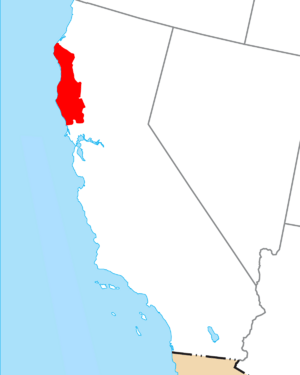Red-bellied newt facts for kids
Quick facts for kids Red-bellied newt |
|
|---|---|
 |
|
| Conservation status | |
| Scientific classification | |
| Genus: |
Taricha
|
| Species: |
rivularis
|
 |
|
| Red-bellied newt distribution | |
The red-bellied newt (Taricha rivularis) is a type of newt. It lives in the coastal forests of northern California. This newt spends most of its life on land.
Contents
What Does a Red-Bellied Newt Look Like?
When fully grown, a red-bellied newt is about 2.75 to 3.5 in (70 to 89 mm) long from its nose to its vent. Its total length, including the tail, can be 5.5 and 7.5 in (140 and 190 mm).
These newts have bumpy skin. Their top side is brownish-black. Their belly is a bright, tomato-red color. Male newts often have a dark, wide mark near their vent. Females do not have this mark. When it's time to breed, males get smooth skin and a flatter tail.
You can tell a red-bellied newt apart from other newts by its red belly. Also, it does not have yellow in its eyes.
Where Do Red-Bellied Newts Live?
Red-bellied newts are found along the coast of California. They live from Bodega in Sonoma County up to Honeydew in Humboldt County. They also live inland to Lower Lake.
These newts prefer coastal woodlands. They especially like redwood forests. There is also a small group of these newts far south of Sonoma County. They live in the Santa Cruz Mountains.
Red-Bellied Newt Life Cycle and Reproduction
Newts start their lives as tiny larvae in the water. They look a bit like tadpoles but are longer. They also have gills on the outside of their bodies.
After about four to six months, the larvae grow into adult newts. They then leave the water. They live underground until they are ready to breed. This usually takes four to six years. Red-bellied newts can live for a very long time, often 20 to 30 years!
When they are old enough to breed, male newts gather at stream banks. This happens as early as January or February. Females join them one to three weeks later to mate.
Red-bellied newts lay their eggs in fast-moving streams or rocky rivers. Females lay their eggs in small groups. Each group has about 6 to 16 eggs. They attach these egg clusters to the bottom of rocks. They also use branches or roots that hang into the stream.
After breeding, the adult newts leave the stream. They move uphill at an angle, heading slightly upstream. Unlike males, female newts do not breed every single year.
Amazing Homing Ability
Red-bellied newts have a special skill called homing. This means they can always find their way back to the same spot in a stream. They can travel several miles over rough land to get there. Scientists think they use their sense of smell to find their way home.
How Red-Bellied Newts Defend Themselves
The brownish-black color on their backs helps red-bellied newts hide. If they are seen and bothered, they have a trick! They pull their heads and tails back. This shows off their bright-red undersides. This red color is a warning to animals that might want to eat them.
Red-bellied newts have a strong poison in their skin, eggs, and embryos. This poison is called tetrodotoxin. It is strong enough to harm a human. Because they are so poisonous, almost no animals eat them. Only a few types of snakes can eat them because they are resistant to the toxin.
Like other newts, red-bellied newts can regrow many body parts. This includes their limbs, eyes, hearts, and even parts of their spinal cords.


